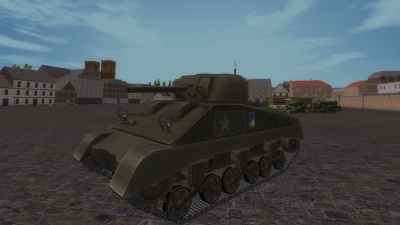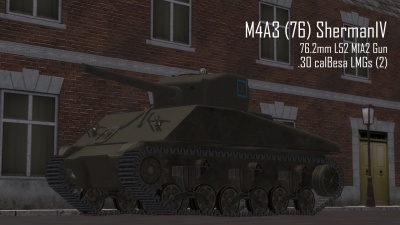M4 Sherman
M4A2 Sherman
History
| 400px | |
| Main Gun Optics | |
| Specifications | |
| Designation | ? |
| Magnification | ? |
| Field of View | ? |
Originally designed as an exploitation tank, the Medium Tank M4 had excellent reliability, good speed and a 75mm gun with excellent HE rounds. Oddly, US doctrine dictated that only tank destroyers would engage enemy tanks and little attention was paid to its anti-tank capability. Despite this, the M4 - known as the Sherman - became the standard Allied tank by 1944 due to its availability in huge numbers, a result of American manufacturing resources and a lack of any better American product.
When it was first proposed, the Sherman would have dominated the battlefield, but by the time it was deployed, its 75mm gun was outclassed by every other nation’s 75 mm weapons. Various crash programs tried to rectify this, resulting in the conversion of the basic form into numerous subtypes with guns such as the 76 mm M1 Gun, the British 17 Pdr, and even the 105 mm M4 Howitzer.
The M4A2 and its 75mm gun had difficulty dealing with the German Panthers (PzKpfw V) and Tigers (PzKpfw VI), particularly head on. Swarm attacks would help one of the Shermans circle around for a flank or rear shot, but these were tactics of necessity. Another fault of the tank was its size. The Sherman sat high, and its high silhouette would hamper it in ambush.
The Sherman also had a reputation for brewing up. Early Shermans stowed ammunition in dry racks along the walls of the tank. When hit, the ammo would explode and the tank would burn. Its reputation led the Germans to nickname the tank the "Tommy cooker". The British called them "Ronsons", after the cigarette lighter with the slogan "Lights up the first time, every time!". Polish Tankers called them "The Burning Grave".
In an early attempt to rectify the problem, Shermans gained 1-inch-thick armored plates welded to the hull outside the ammunition bins. Later models moved ammunition stowage to the floor and used bags containing a mix of water and ethylene glycol to flood "ready" ammunition below the turret, which kept the risk of fire under control.
Game Play
Despite its shortcomings, the Sherman is a decent medium tank. The high silhouette is not only a disadvantage - it also improves the commander's visibility on the battlefield and it’s easier to find a hull-down position.
Expect to be outranged in gun duels against 75 mm-armed German tanks because your 75 mm is a low-velocity gun. Find a partner and work in teams with a M10 Wolverine and its high-velocity 3 inch gun to essentially recreate the real-time response to the unusual American anti-tank doctrine.
Use cover to keep encounter ranges short where possible. Your HE shell are extremely effective in clearing out buildings and bunkers, but your AP will perform roughly similar to smaller calibers such as the QF 6 Pdr, which fires a smaller 57mm projectile at much higher muzzle velocity. For a medium tank, the Sherman is fast and maneuverable with rapid enough turret rotation to provide an advantage in short-range mobile engagements. This is where you can make up for the 75 mm's poor muzzle velocity - get close where your gun can give you that little bit of extra penetration performance it lacks at longer ranges.
The Sherman has only reasonable armor in most respects - it isn’t a heavy tank. The front turret and mantle are quite thick, and the front glacis has a good slope angle to it, which gives incoming rounds a difficult slope to take purchase on. Longer ranged rounds will bounce or ricochet off. Your hull sides are thin, however, as is the rear hull plate, so try to keep your front facing the enemy. You can increase the effectiveness of the armor by presenting a slight angle off the nose to the enemy - just don't turn enough to expose your weak side as a target.
The driver position in this tank has no view slit, you must either use the periscope (numpad “.” or “Del” key) or unbutton with the “O” key. Unbuttoning will pop your drivers head through the top hull plate into the open air. Crew position 4 has a hull .30 cal LMG with gunsight. Position 4 can unbutton like the driver.
M4A3 Sherman
History
| 400px | |
| Main Gun Optics | |
| Specifications | |
| Designation | ? |
| Magnification | ? |
| Field of View | ? |
This M4A3 version of the Medium Tank M4 series carried the new high-velocity 76 mm M1 Gun into battle against German tanks, which were generally too heavily armored for the low-velocity 75 mm M3 Gun issued with the original Sherman tank. The M4A3 retained the barely adequate armor of the original Sherman but its higher velocity gun performed very much better against German armor than the 75 mm ever could.
Although larger in caliber, the 76 mm M1 threw a slightly weaker HE shell than the Sherman's original 75 mm gun.
Note that the M4A3 is not the same as the British Firefly, which was a Sherman with a QF 17 Pdr anti-tank gun. The 17 Pdr was nearly identical in caliber to the American 76 mm M1, but was a more potent weapon.

